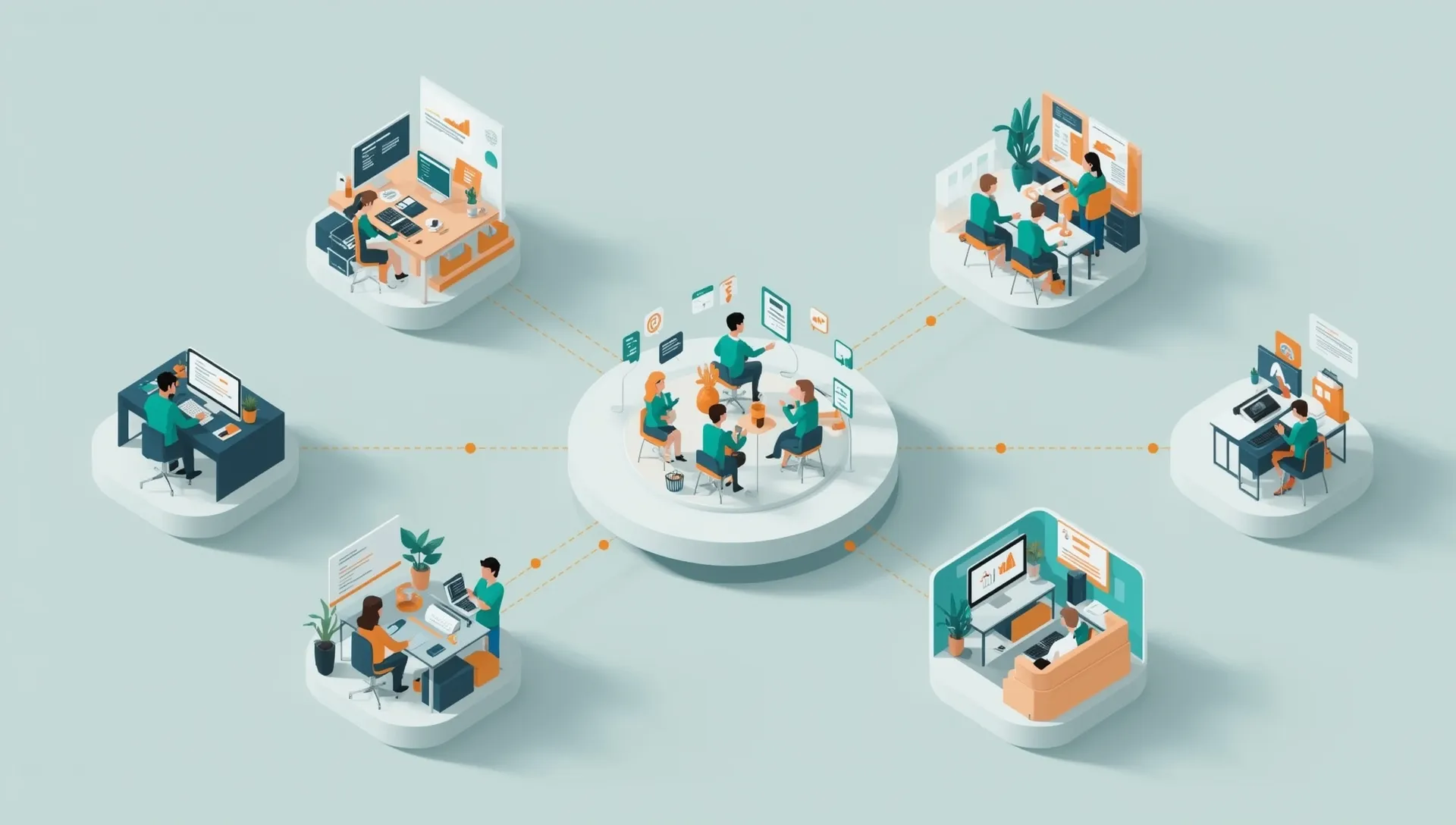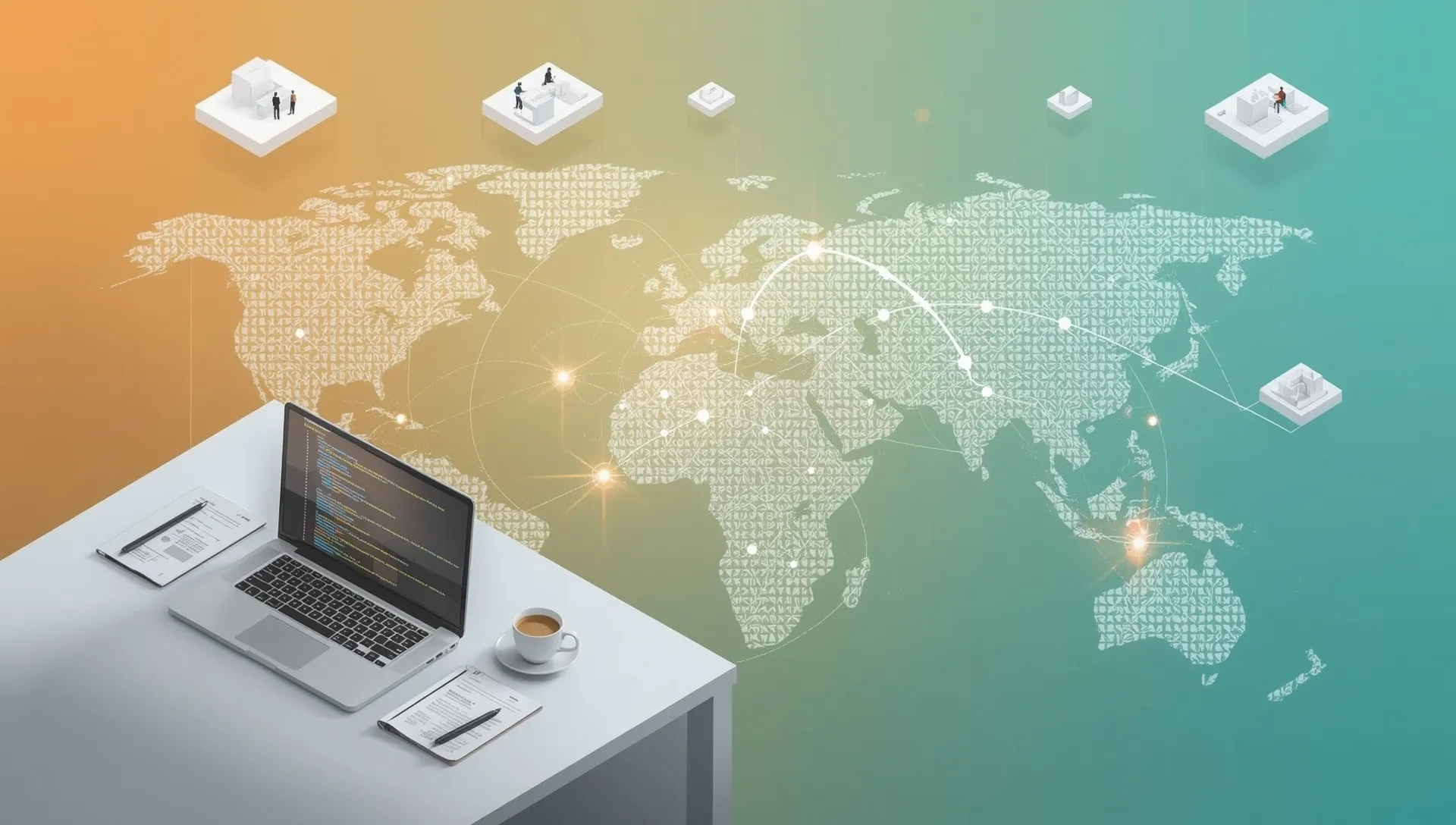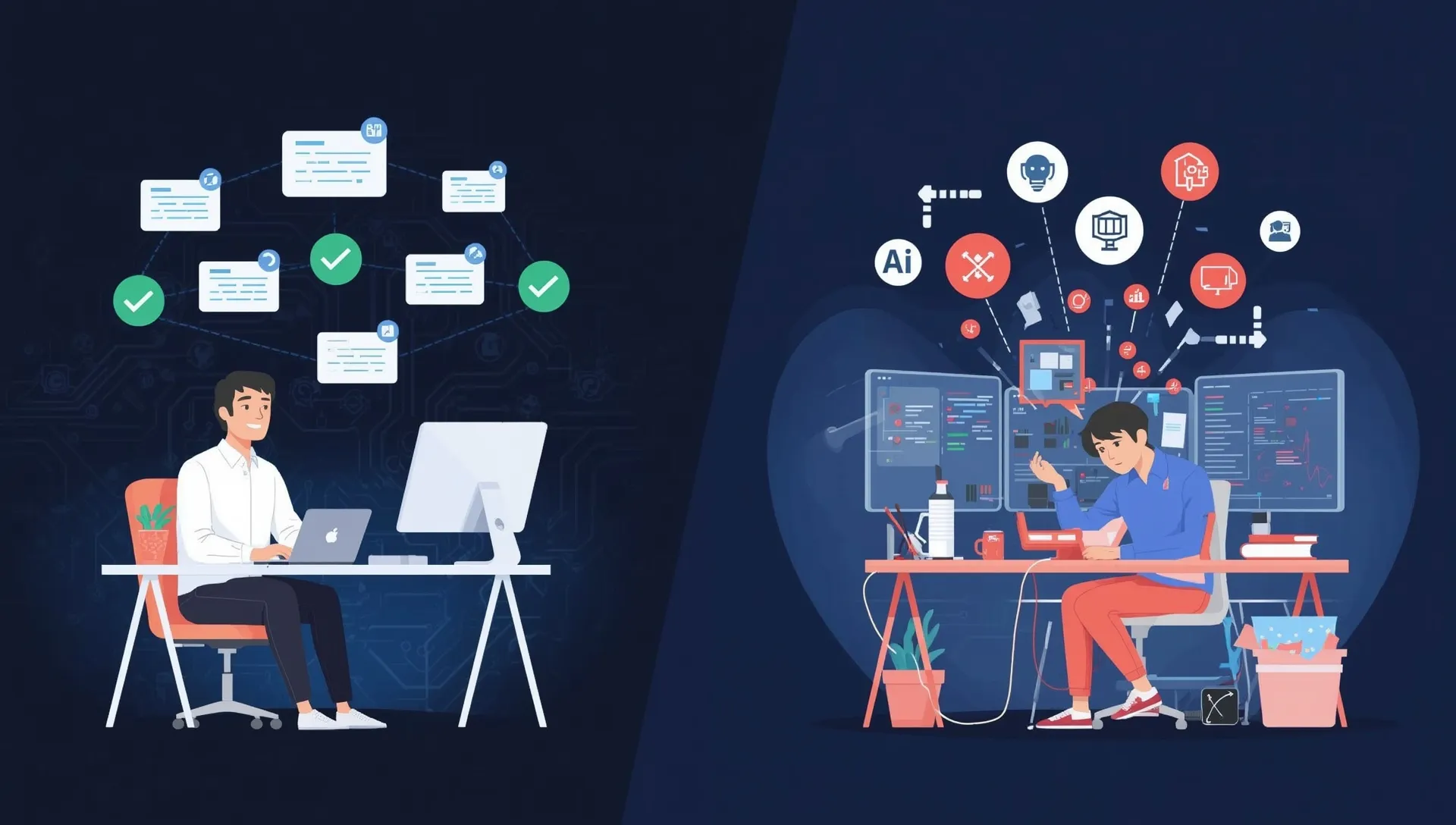
Building engineering culture remotely: lessons from distributed teams
Remote engineering teams face unique culture challenges that can make or break productivity and retention. Here are proven strategies for building strong engineering culture across distributed teams, from onboarding to collaboration practices.
“We hired our best engineer from a different timezone, but now the team feels disconnected and productivity is dropping.”
This founder’s dilemma captures the biggest challenge facing engineering teams today: maintaining strong culture and collaboration across distributed teams. After eight years of building and leading remote engineering teams, I’ve learned that engineering culture doesn’t just survive remotely - it can actually become stronger than traditional in-person teams.
But only if you design it intentionally.
The mistake most teams make is trying to recreate their in-person culture through video calls and Slack channels. Remote engineering culture requires fundamentally different approaches to communication, collaboration, knowledge sharing, and team building.
Here’s how to build strong engineering culture that thrives across distributed teams, timezones, and working styles.
Why traditional engineering culture doesn’t work remotely
The osmosis myth
In traditional offices, teams rely on “cultural osmosis” - the idea that team members absorb culture, practices, and knowledge through proximity and casual interactions. This creates several invisible dependencies:
Hallway Conversations: Important technical decisions and context sharing happen in informal conversations that remote team members miss entirely.
Visual Learning: Newer engineers learn by watching senior developers work, seeing debugging approaches, and observing decision-making processes in real time.
Spontaneous Collaboration: Complex problems get solved through impromptu whiteboard sessions and over-the-shoulder code reviews.
Social Cohesion: Team relationships develop through shared experiences like lunch conversations, coffee breaks, and after-work activities.
These dependencies break down completely in remote environments, leaving distributed teams feeling disconnected and unproductive.
The asynchronous communication challenge
Remote teams must operate across different timezones, working schedules, and communication preferences. This creates new challenges that office-based teams never face:
Context Loss: Messages lack the visual and verbal cues that help team members understand tone, urgency, and importance.
Decision Delays: Important technical decisions get stuck waiting for synchronous meetings or real-time discussions.
Knowledge Fragmentation: Critical information gets scattered across different communication tools and timeframes.
Unequal Participation: Team members in certain timezones or with specific communication styles can become marginalized.
Facing a leadership challenge right now?
Don't wait for the next fire to burn you out. In a 30-minute discovery call we'll map your blockers and outline next steps you can use immediately with your team.
Foundation principles for remote engineering culture
Documentation as cultural infrastructure
In remote teams, documentation becomes culture, not just a nice-to-have. Strong remote engineering cultures are built on comprehensive, accessible documentation that serves multiple purposes:
Decision Records: Document not just what decisions were made, but why they were made, what alternatives were considered, and what context informed the choice.
Process Clarity: Every team process, from code reviews to deployment procedures, needs clear documentation that enables consistent execution regardless of who’s available.
Knowledge Base: Create searchable repositories of common problems, solutions, and institutional knowledge that prevent repeated questions and enable self-service learning.
Culture Documentation: Explicitly document team values, communication preferences, collaboration patterns, and expectations rather than assuming they’ll be understood implicitly.
Asynchronous-first communication patterns
Successful remote engineering teams prioritize asynchronous communication while preserving space for synchronous collaboration when needed:
Written Context: Important discussions happen in written form where everyone can participate regardless of timezone and decisions are automatically documented.
Structured Updates: Regular, structured progress updates replace ad-hoc status conversations and provide visibility across the entire team.
Pull-Based Information: Team members can access the information they need when they need it, rather than waiting for someone to push information to them.
Escalation Paths: Clear guidelines for when asynchronous communication should escalate to synchronous discussions or decisions.
Building collaboration systems that work across timezones
Code review as cultural cornerstone
In remote teams, code review becomes the primary mechanism for knowledge sharing, quality control, and cultural reinforcement:
Comprehensive Review Standards: Establish clear expectations for code review scope, timeline, and quality that create consistent experiences regardless of reviewer timezone.
Educational Reviews: Use code reviews as teaching opportunities where senior developers explain reasoning, suggest improvements, and share institutional knowledge.
Cultural Reinforcement: Code reviews become opportunities to reinforce team values around code quality, security practices, and architectural decisions.
Asynchronous Mentoring: Senior developers can mentor junior team members through detailed code review feedback without requiring real-time interaction.
Structured knowledge sharing
Remote teams need deliberate practices for sharing knowledge that would traditionally happen through osmosis:
Technical Deep Dives: Regular presentations where team members share learning from complex problems, new technologies, or architectural decisions.
Documentation Reviews: Systematic review and improvement of team documentation to ensure it remains current and useful.
Learning Sessions: Structured time for team members to teach each other about tools, techniques, or domain knowledge.
Post-Mortem Culture: Comprehensive incident post-mortems that focus on system improvement rather than individual blame.
Collaborative problem-solving frameworks
Complex technical problems need structured approaches that work asynchronously:
Problem Definition Templates: Standardized formats for describing technical problems that ensure all relevant context is captured and shared.
Solution Design Processes: Collaborative approaches to technical design that allow distributed input without requiring everyone to be online simultaneously.
Decision-Making Frameworks: Clear processes for making technical decisions that balance input gathering with execution speed.
Consensus Building: Techniques for building technical consensus across distributed teams without endless meetings.
Coaching for Tech Leads & CTOs
Ongoing 1:1 coaching for startup leaders who want accountability, proven frameworks, and a partner to help them succeed under pressure.
Onboarding remote engineers for cultural success
Structured onboarding programs
Remote onboarding requires significantly more structure than in-person approaches:
Pre-Start Preparation: Send equipment, access credentials, and initial reading materials before the engineer’s start date to eliminate first-day friction.
Cultural Immersion: Deliberate introduction to team values, communication patterns, and collaboration practices through documentation and guided experiences.
Technical Environment Setup: Comprehensive guides and support for setting up development environments, tools, and access permissions.
Relationship Building: Structured introductions to team members, including their roles, expertise areas, and preferred communication styles.
Mentorship and buddy systems
Remote engineers need explicit support systems that replace natural in-person learning:
Technical Mentors: Assign experienced engineers to provide technical guidance, answer questions, and review early work contributions.
Cultural Buddies: Pair new engineers with team members who can explain unwritten rules, team dynamics, and communication norms.
Graduated Responsibility: Plan progressive increases in responsibility and autonomy as new engineers demonstrate competence and cultural alignment.
Regular Check-ins: Scheduled one-on-one meetings to address questions, concerns, and feedback during the critical early months.
Knowledge transfer acceleration
Remote engineers need faster access to institutional knowledge:
Comprehensive Documentation: Up-to-date technical documentation, process guides, and architectural decision records.
Video Libraries: Recorded sessions covering common tasks, debugging approaches, and system walkthroughs.
Sandbox Environments: Safe spaces for new engineers to experiment, break things, and learn without impacting production systems.
Learning Paths: Structured sequences of tasks, reading, and exercises that help new engineers build competence systematically.
Communication practices that build remote culture
Meeting optimization for distributed teams
Remote teams need different meeting practices than in-person teams:
Default to Asynchronous: Assume most communication can happen asynchronously unless there’s a specific need for real-time interaction.
Meeting Purpose Clarity: Every meeting needs a clear purpose, agenda, and expected outcomes that justify the synchronous time investment.
Inclusive Scheduling: Consider timezone impact when scheduling meetings and rotate meeting times to share the burden of inconvenient hours.
Documentation Requirements: Meeting outcomes, decisions, and action items must be documented for team members who couldn’t attend.
Status communication systems
Remote teams need systematic approaches to status communication:
Regular Written Updates: Structured updates that provide visibility into progress, blockers, and priorities without requiring meetings.
Shared Dashboards: Visual systems that provide real-time visibility into project status, team velocity, and system health.
Proactive Communication: Team members take responsibility for communicating status changes, blockers, and needs rather than waiting to be asked.
Context Preservation: Communication includes enough context for team members to understand implications and make informed decisions.
Conflict resolution in remote environments
Remote teams need explicit approaches to handling disagreements and conflicts:
Early Intervention: Address communication issues and disagreements quickly before they escalate or damage relationships.
Structured Discussions: Use frameworks for technical disagreements that focus on data, requirements, and trade-offs rather than personal preferences.
Private Resolution: Handle interpersonal conflicts through private conversations before involving broader team discussions.
Cultural Reinforcement: Use conflict resolution as opportunities to reinforce team values and communication expectations.
Got a leadership question?
Share your toughest challenge and I might feature it in an upcoming episode. It's free, anonymous, and you'll get extra resources in return.
Measuring and maintaining remote culture health
Cultural health indicators
Remote teams need metrics that help them understand cultural strength:
Knowledge Sharing Activity: Track documentation contributions, code review participation, and learning session engagement.
Communication Health: Monitor response times, question resolution rates, and cross-timezone collaboration patterns.
Team Satisfaction: Regular surveys about remote work satisfaction, cultural alignment, and collaboration effectiveness.
Retention and Growth: Track team member retention, internal promotion rates, and new hire success metrics.
Continuous culture improvement
Strong remote cultures evolve through systematic improvement:
Regular Retrospectives: Team retrospectives that include cultural and process improvement alongside technical project review.
Practice Experiments: Try new collaboration tools, communication patterns, and cultural practices with defined success criteria.
Feedback Integration: Systematic collection and integration of feedback about remote work practices and cultural elements.
Best Practice Sharing: Regular sharing of successful practices across teams and organizations.
Tools and technology for remote culture
Communication tool strategy
Remote teams need thoughtful approaches to communication tools:
Tool Purpose Clarity: Each communication tool should have a clear purpose and usage guidelines to prevent confusion and scattered conversations.
Asynchronous Preference: Prioritize tools that support asynchronous communication while maintaining conversation context and history.
Integration Strategy: Ensure tools integrate well with development workflows and don’t create additional context switching overhead.
Accessibility Considerations: Choose tools that work well across different devices, internet connections, and accessibility needs.
Collaboration platform design
Remote engineering teams need platforms that support their specific workflows:
Code Collaboration: Tools that enable effective code review, pair programming, and collaborative debugging across timezones.
Design Collaboration: Shared spaces for technical design, architecture discussions, and system diagramming.
Documentation Systems: Searchable, maintainable documentation platforms that integrate with development workflows.
Knowledge Management: Systems that help capture, organize, and surface institutional knowledge and decision history.
Special considerations for hybrid teams
Managing mixed remote and in-person dynamics
Hybrid teams face unique challenges that require specific attention:
Inclusion Equality: Ensure remote team members have equal access to information, decision-making, and career opportunities.
Communication Standards: Establish communication practices that work for both remote and in-person team members.
Meeting Practices: Design meeting formats that include remote participants as first-class attendees, not afterthoughts.
Cultural Cohesion: Build team culture that values contributions over presence and results over location.
Avoiding two-tier team structures
Hybrid teams risk creating implicit hierarchies between remote and in-person team members:
Leadership Modeling: Team leaders must demonstrate inclusive practices and call out behaviors that marginalize remote team members.
Equal Access: Ensure remote team members have equal access to mentorship, growth opportunities, and important conversations.
Cultural Integration: Build team traditions and practices that work for all team members regardless of location.
Performance Evaluation: Use performance criteria that value outcomes and contributions rather than physical presence or office participation.
Long-term remote culture sustainability
Scaling remote culture practices
As remote teams grow, culture practices need to evolve:
Process Scalability: Design cultural practices that work with larger teams and don’t require manual coordination from team leaders.
Knowledge Management: Implement systems that preserve institutional knowledge and cultural practices as team composition changes.
Leadership Development: Develop multiple team members who can facilitate cultural practices and support team cohesion.
Cultural Documentation: Maintain explicit documentation of cultural practices, values, and expectations that can onboard new team members.
Evolution and adaptation
Strong remote cultures adapt to changing needs and circumstances:
Regular Assessment: Systematically evaluate which cultural practices are working and which need improvement or replacement.
Practice Innovation: Encourage team members to propose and experiment with new cultural practices and collaboration approaches.
External Learning: Learn from other successful remote teams and adapt practices that align with team values and needs.
Change Management: Handle cultural changes thoughtfully with team input and gradual implementation rather than sudden shifts.
Connection to broader technical leadership
Building strong remote engineering culture requires many of the same skills as traditional technical leadership, but applied differently:
Remote team leadership becomes even more critical when team members are distributed across locations and timezones.
Scaling engineering culture practices need adaptation for remote environments where culture can’t rely on physical proximity.
The principles remain the same, but the implementation requires intentional design for distributed collaboration.
Conclusion: remote culture as competitive advantage
Strong remote engineering culture isn’t just about making distributed teams work - it’s about creating competitive advantages that traditional in-person teams can’t match.
Remote teams with strong culture can:
Access Global Talent: Hire the best engineers regardless of location rather than being limited to local talent pools.
Operate Continuously: Leverage timezone differences for continuous development, support, and problem-solving.
Document Everything: Build comprehensive knowledge bases and decision records that accelerate onboarding and reduce key person dependencies.
Focus on Results: Create performance cultures based on outcomes and contributions rather than presence and politics.
The investment in intentional design
Building strong remote engineering culture requires upfront investment in systems, processes, and practices. But teams that make this investment create sustainable competitive advantages and engineering environments that consistently attract and retain top talent.
The key is recognizing that remote culture requires intentional design rather than trying to recreate in-person culture through digital tools.
Getting started with remote culture building
Whether you’re transitioning an existing team to remote work or building a distributed team from scratch, start with the fundamentals:
- Document your current culture explicitly rather than assuming it’s understood
- Design asynchronous communication patterns that include rather than exclude
- Create structured onboarding that accelerates cultural integration
- Measure cultural health through feedback and team satisfaction metrics
- Iterate and improve based on what works for your specific team
Remote engineering culture isn’t just possible - when done well, it creates stronger, more resilient, and more innovative teams than traditional in-person approaches.
Facing a leadership challenge right now?
Don't wait for the next fire to burn you out. In a 30-minute discovery call we'll map your blockers and outline next steps you can use immediately with your team.
I’ve helped numerous engineering teams transition to remote work and build strong distributed cultures that improve both productivity and team satisfaction. If you’re looking to strengthen your remote engineering culture or transition to distributed team practices, I’d be happy to discuss how fractional CTO support can help design and implement cultural practices that work for your specific team.
📈 Join 2,000+ Tech Leaders
Get my weekly leadership insights delivered every Tuesday. Team scaling tactics, hiring frameworks, and real wins from the trenches.
Related Articles

Surviving a key developer departure: business continuity planning
When your most critical engineer gives notice, you have 2-4 weeks to prevent business catastrophe. After helping dozens of companies navigate key person departures, here's the systematic approach to knowledge transfer and team resilience that can save your startup.

The hidden cost of cheap developers: why offshore teams need senior oversight
Offshore development can save money upfront, but without senior technical oversight, you'll pay far more fixing poor code quality, security vulnerabilities, and architectural disasters. Here's how to make offshore teams successful.

AI coding tools: senior developer superpower or junior developer trap?
AI coding assistants can dramatically accelerate experienced developers, but they're creating a generation of "vibe coders" who can't distinguish good code from disasters. Here's why you need senior technical leadership to harness AI effectively.
